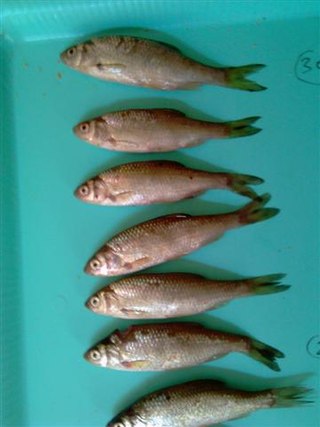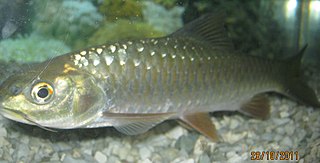
Mackerel is a common name applied to a number of different species of pelagic fish, mostly from the family Scombridae. They are found in both temperate and tropical seas, mostly living along the coast or offshore in the oceanic environment.

Herring are various species of forage fish, belonging to the order Clupeiformes.

The seamoths make up a family of ray-finned fishes, the Pegasidae, within the order Syngnathiformes. They are named for Pegasus, a creature from Greek mythology. Seamoths are notable for their unusual appearance, including flattened bodies, the presence of large, wing-like, pectoral fins, a long snout, and a body encased in thick, bony plates. They are found primarily in coastal tropical waters of the Indo-Pacific.

The floral banded wobbegong is a recently described species of carpet shark found in the Indian Ocean, at depths of 42 to 85 meters, off southwestern Australia. With a maximum length of up to 75 cm (30 in), it is among the smallest wobbegongs. The physical characteristics consist of a striking color pattern of yellowish-brown bands, blotches, spots, and reticulations.
Clypeobarbus pleuropholis is a species of ray-finned fish belonging to the family Cyprinidae, the family which includes the carps, barbs and related fishes. This species is found in the Chad Basin in Chad and Cameroon, as well as the Congo Basin in Democratic Republic of Congo, the Republic of Congo and the Central African Republic. This species, as Barbus kemoensis, is the type species of the genus Clypeobarbus.

Leptocypris is a genus of freshwater ray-finned fishes belonging to the family Danionidae, the danios or danionins. The fishes in this genus are found in Africa
Luciobrama is a monospecific genus of freshwater ray-finned fish belonging to the family Xenocyprididae, the East Asian minnows or sharpbellies. The only species in the genus is Luciobrama macrocephala, the long spiky-head carp, a fish that is found in China and Vietnam. It is classified as data deficient by the IUCN. It is found in rivers and lakes. Larger fish, over 30 centimetres (12 in) live nearer the bottom and the smaller specimens are found higher in the water column. They are partially migratory. It has not been recorded from four of its known spawning sites since 1988.

Leucos basak, the Albanian roach, Dalmatian roach or Croatian roach, is a species of freshwater fish in the family Cyprinidae. It is found in Albania, Bosnia and Herzegovina, Croatia, and Serbia and Montenegro.
Leptocypris crossensis is a species of freshwater ray-finned fish belonging to the family Danionidae. This fish is found in the Cross, Wouri and Sanaga River basins in Cameroon and Nigeria.
Leptocypris guineensis species of freshwater ray-finned fish belonging to the family Danionidae. This fish is found in Atlantic slope drainages of the Guinean mountain ranges.
Leptocypris lujae is a species of freshwater ray-finned fish belonging to the family Danionidae. This fish is found in the Congo River up to the Lualaba River in the Democratic Republic of Congo and the Central African Republic.
Leptocypris modestus is a species of freshwater ray-finned fish belonging to the family Danionidae. This fish is found in Congo River in the Democratic Republic of Congo and the Central African Republic. It is the type species of the genus Leptocypris.

The Nile minnow is a species of freshwater ray-finned fish belonging to the family Danionidae. This fish is found in the Nile, Omo, Niger, Bénoué, Volta, and Senegal Rivers, and the Lake Chad basin. It was described by Léon-Daniel de Joannis in 1835.
Leptocypris taiaensis is a species of freshwater ray-finned fish belonging to the family Danionidae. This fish is endemic to Taia River, Little Scarcies River and Waanje River in Sierre Leone.
Leptocypris weeksii is a species of freshwater ray-finned fish belonging to the family Danionidae. This fish is found in the lower Congo River, the central and upper Congo River basin, and Pool Malebo in the Democratic Republic of Congo.
Leptocypris weynsii s a species of freshwater ray-finned fish belonging to the family Danionidae. This fish is found in the lower, central and upper Congo River basin and Pool Malebo in the Democratic Republic of Congo and the Central African Republic.

Cabdio jaya, the jaya, is a species of freshwater ray-finned fish belonging to the family Danionidae. This fish is found in India, Nepal and Bangladesh where it occurs in hill streams. This species can reach a length of 15.0 centimetres (5.9 in) TL. This species is the type species of the genus Cabdio.

Neolissochilus hexagonolepis, the copper mahseer, chocolate mahseer or katli, is a species of freshwater ray-finned fish belonging to the family Cyprinidae, the family which includes the carps, barbs and related fishes. This species is found in Nepal, eastern India, Bangladesh, Myanmar, Thailand, Malaysia and Sumatra. It may also be present in China and Viet Nam, also the record sof this species from the easyetn part of its range is uncertain and reports may be misidentifications.








